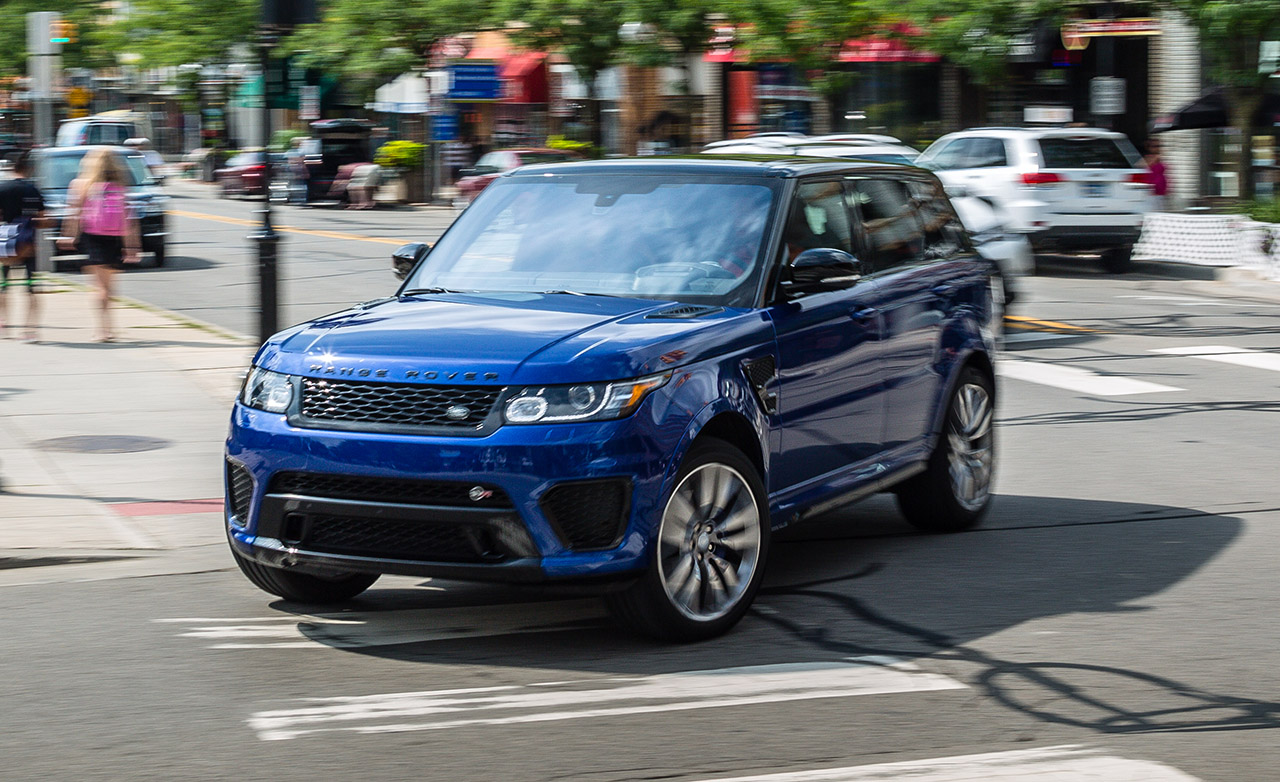The formula is simple: Put stickier performance tires on any vehicle and you can generally see its cornering grip go up and its stopping distances go down. Such was the case with this Range Rover Sport SVR, which we put through our testing regimen on account of the Continental ContiSportContact 5 SUV tires wrapped around its seductively styled 22-inch wheels, all together a $3000 option. That fitment contrasts with the standard 21-inch Michelin Latitude Sport M+S all-seasons fitted to the last SVR we tested, a 2015 model packing the same ludicrously torquey supercharged V-8.
It also had the same fantastically bawdy battle cry to announce its 550 horsepower and 502 lb-ft of torque. In this case, that output delivered a 4.6-second zero-to-60-mph run. That’s 0.3 second behind the previous SVR we tested, but that could be down to a greener engine (this one had 1800 miles, 2700 fewer than the previous example) or simple production variance. We’d chalk it up to the latter (and perhaps the 22-inch wheels and tires are heavier), as this SVR fell farther behind as the acceleration run went on, coming in 0.5 second behind at 100 mph and 2.2 seconds at 140. Rivals such as BMW’s X5 M and X6 M and the Porsche Cayenne Turbo remain quicker, but complaining about a 5500-pound vehicle that can reach 60 mph in 4.6 seconds is sort of like griping about a bourbon that’s “only” 90 proof.
As for the ContiSportContact 5 SUV tires, they enabled this SVR to shave 12 feet off the 70-to-zero-mph stopping distance, halting in a respectable 167 feet. The tires also increased lateral grip on our skidpad from 0.87 to 0.89 g, a small gain that was also reflected in slightly improved turn-in response on the road. Indeed, bend the SVR into a corner and where you expect it to push toward the outside it instead obediently follows your intended line, aided by the brake-based pseudo torque-vectoring on the rear axle. The brake pedal feels a bit dead at the top of its travel, but it’s predictable in use and we detected no fade at our test track or on the road. Once you’re used to the SVR’s size and its abilities, you begin to roar up to corners, turn in, and power out as you might in much smaller, lighter vehicles.
Such shenanigans are less likely to draw unwanted attention in the SVR due to its moderate exterior makeover from a regular Range Rover Sport, including a more intake-intensive front fascia, four exhaust tips, and blacked-out details. The notable changes in the lavish cabin are well-sculpted, fixed-headrest front seats—with holes in each seatback to accommodate a racing harness, naturally—and aluminum interior trim. The bright $1800 Estoril Blue paint (apparently all luxury manufacturers must offer a color so named) isn’t for the shy, but most bystanders won’t see anything other than a genteel British SUV, and why would one of those be coming around that corner all sideways and angry?
On top of its $112,345 base price, our SVR also had $2900 in parking and lane-departure assistants, a $4450 1700-watt Meridian audio system, and a $650 towing package because why the hell not? The total was $126,032, to which you’ll need to add at least a couple grand for some winter wheels and tires if you live anywhere with four distinct seasons.
We don’t have any fuel-economy data for this particular SVR—the dog ate our homework—but suffice it to say that the gummier rubber compound likely wouldn’t have improved on the 14 mpg we recorded from our earlier test vehicle. But then we assume miles per gallon aren’t a high priority for those shopping for 550-hp SUVs. Instead, such people are after stylishness, high performance, and, often, cosseting luxury. Oh, and a dash of ludicrousness. No matter which shoes it’s wearing, the Range Rover Sport SVR offers plenty of all of those things.
Source: http://www.caranddriver.com/reviews/2016-range-rover-sport-svr-tested-on-performance-tires-review



